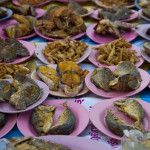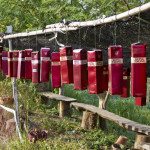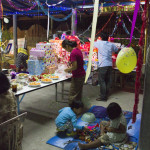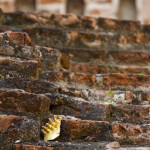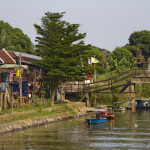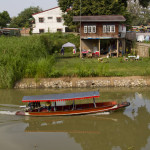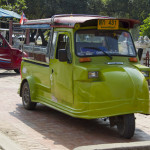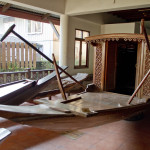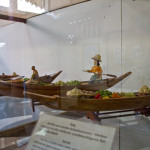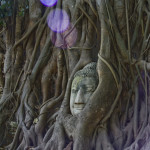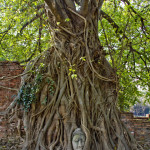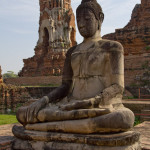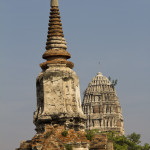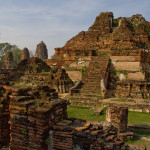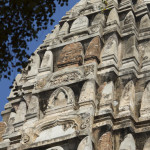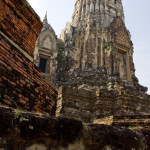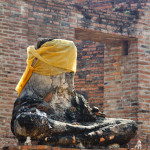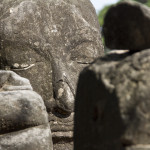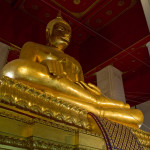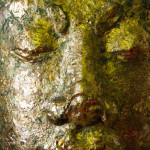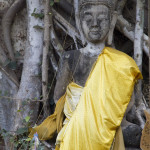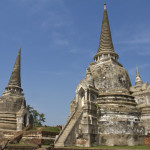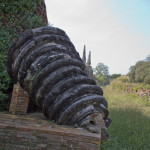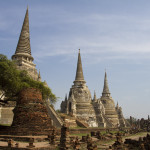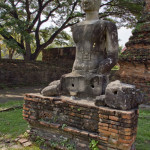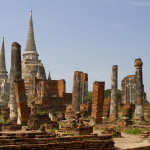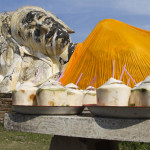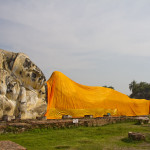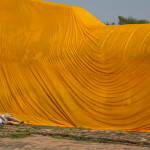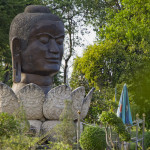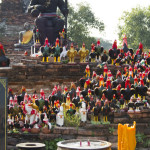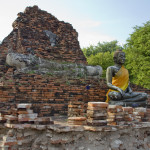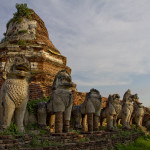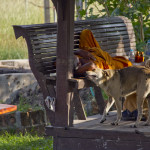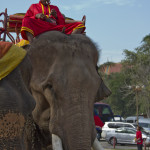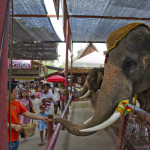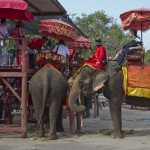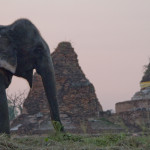https://www.youtube.com/watch?v=i9UPf4JLmmk
80 kilometres north from Bangkok, only 2 hours away by train (+scheduled delay), this is the former capital city, ransacked by Burmese army in 1767. And ever since the city has not recovered. Though quite big in size, Ayutthaya feels very provincial and tourist come here mostly to see the ruins of former Siam capital. One of the tourists also arrives here to sped the New Year’s Eve. And – accidentally – gets invited to a neighbourhood party. Though our communication options are quite limited, me and my hosts go along very well, especially when it comes to tasting local whisky and snacks. We watch artistic-karaoke performances taking place on the stage put up together by neighbours – the folk-pop tunes make us drown into nostalgia, the state that I have to get out of in order to make it back to my hostel (B.J’s, 120 baht a for a room). The host wants to offer me a ride and I should not worry about all the alcohol he took in – he has many friends among the police. I somehow manage to refuse the generous offer and I catch a lift (sober driver on a scooter). Before I go to sleep I witness/participate in two other New Year’s Eve “parties” – one is a collective prayer of hundreds of people in a temple, the other one is karaoke in front of the hostel (I am forced to sing an unknown tune in Thai).
80 km na północ od Bangkoku, jedynie 2 godziny jazdy pociągiem (+planowe opóźnienie), oto była stolica, splądrowana przez Birmańczyków w 1767 r. I właściwie od tego czasu nie podniosła się z gruzów. Mimo sporych rozmiarów, miasto ma mocno prowincjonalny posmak, a turyści wybierają się tu głównie by obejrzeć ruiny byłej stolicy imperium Siamu. Jeden turysta dociera tu również w celu spędzenia Sylwestra. I zostaje – zupełnie przypadkowo – wciągnięty na imprezę sąsiedzką. Choć możliwości komunikacyjne ja i gospodarze mamy ograniczone, to rozumiemy doskonale, jak się pije whisky, zagryzając pikantnymi przekąskami. Oglądamy występy artystyczne na stworzonej wspólnymi sąsiedzkimi siłami scenie – folkowo-popowe kawałki wprawiają nas w stan nostalgii, z którego muszę się wyrwać, żeby wrócić do hostelu (B.J.’s, 120 bahtów za pokój). Gospodarz oferuje podwiezienie skuterem, mam się nie przejmować wypitym przezeń alkoholem, ma znajomych policjantów, nic nam nie grozi. Ostatecznie jednak udaje mi się wymigać i łapię stopa (również skuter, kierowca jest trzeźwy). Zanim położę się spać, zaliczam jeszcze dwie „imprezy” sylwestrowe – jedna to wspólna medytacja setek wiernych w świątyni, a druga to karaoke przed hostelem (zostaję zmuszony do odśpiewania zupełnie mi nieznanego tajskiego kawałka).
Thai Boat Museum / Muzeum Łodzi
The best way to discover Ayutthaya is to rent a bike (30-40 baht a day) – this is how I make my way to the museum created by an enthusiast, lecturer and constructor of boats – Mr. Paitoon Khawmala. He also created small scale models of boats that would not fit in his house and garden. Recognizing his merits, His Majesty the King met Mr. Paitoon and awarded him high distinctions. It seems that the King himself also used to spend a lot of time around boats.
Zwiedzanie Ayutthai najlepiej odbyć na rowerze (30-40 bahtów za dzień) – ja tak właśnie uczyniłem i zacząłem od muzeum, stworzonego przez pasjonata, wykładowcę i konstruktora łodzi – Pana Paitoona Khawmala – na terenie swojej posesji. Sam stworzył również makiety łodzi i statków. W uznaniu jego zasług, sam król spotkał z Panem Paitoonem i przyznał mu wysokie odznaczenia państwowe. Sam król lubił zresztą swego czasu pobawić się w konstruowanie łodzi.
Wat Mahathat
Ayutthaya is first of all about the ruins of wats (temples) and one of the most iconic ones is Wat Mahathat. Watch out for the photogenic Buddha head somehow stuck in the roots of banyan tree. The temple itself was built in 14th century and the remains are quite picturesque.
Ayutthaya to przede wszystkim ruiny watów, czyli świątyń, a jednym z najbardziej rozpoznawalnych watów jest Wat Mahathat. Niezwykle fotogeniczna jest głowa Buddy, która – nie wiadomo jakim sposobem – utknęła w objęciach drzewa banianowego. Sama świątynia zaś została wybudowana w XIV w. i pozostały po niej malownicze pozostałości.
Wat Ratchaburana
Located right next to Wat Mahathat – it has a photogenic Khmer-style prang, partially restored.
Tuż obok Wat Mahathat – fotogeniczny prang w stylu khmerskim, częściowo odrestaurowany.
Wat Phra Mongkol Bophit
Big sized sitting Buddha in a nicely maintained temple.
Sporej wielkości siedzący Budda w ładnie utrzymanej świątyni.
Wat Phra Si Sanphet
A must see and must-photo, too. Three huge chedis stand for three kings that were buried here. Forget not that the three structures are mere reconstructions – don’t believe what the guards say about the authenticity of the site. In other places you can spot somewhat naive efforts to over-dramatize the setting.
Bez masy zdjęć się nie obędzie. Trzy wielkie chedi symbolizują trzech królów tu pochowanych. Nie należy jednak zapominać, że wspomniane trzy konstrukcje to właściwie rekonstrukcje – niezależnie od tego, co próbują Wam wciskać obruszeni strażnicy. W paru innych miejscach widać też dość prostackie zabiegi mające na celu udramatyzowanie scenerii.
Wat Lokayasutharam
Restored but still attractive in his own elderly way reclining Buddha (37 m long).
Również odrestaurowany ale nic nie tracący ze swego starczego powabu leżący Budda (37 m długości), przed którym wierni składają w ofierze różne artykuły spożywcze.
Wat Thammikarat
One more wat, OK? Apart from the ordinary lions and naga (multiheaded snake) the temple also hosts many sigurines of roosters placed around the statue of local ruler who defeated the invaders.
No to może jeszcze jeden wat – oprócz zwyczajnych figur lwów i naga (wielogłowego węża), świątynia może się poszczycić dużą ilością figurek kogutów ustawionych wokół rzeźby lokalnego władcy, który dał odpór najeźdźcom.
Elephants / Słonie
Wats aside, this is the most important tourist attraction in Ayutthaya. The elephants roam around here and there, carrying Euro-fatties and Asia-skinnies on their backs. The tourists are definitely enjoying it, the elephants – not so much probably. There are plenty other pseudo-educative activites taking place, including elephants talking to a microphone. They say that Elephant Kraal who run this whole business are seeing to that the elephants don’t get too tired. I don’t know the outcome but it is true that the animals look more chilled out of office hours in their “home” outside city centre.
To najważniejsza, oprócz watów, atrakcja turystyczna Ayutthai. Słonie dostojnie człapią to tu, to tam, dźwigając na plecach eurogrubasów i azjochudzielców. Turyści mają z tego sporo frajdy, słonie raczej trochę mniej. Poza tym prowadzone są pseudoedukacyjne zajęcia, podczas których słonie np. mówią do mikrofonu. Ponoć Elephant Kraal (Schronisko słoniowe), które zarządza tym całym interesem dba o to, by słonie się nie przemęczały. Nie wiem jak jest naprawdę, ale faktem jest, że oglądając słonie „po godzinach” w ich „domu” poza centrum miasta, ma się wrażenie, iż są bardziej wyluzowane.


